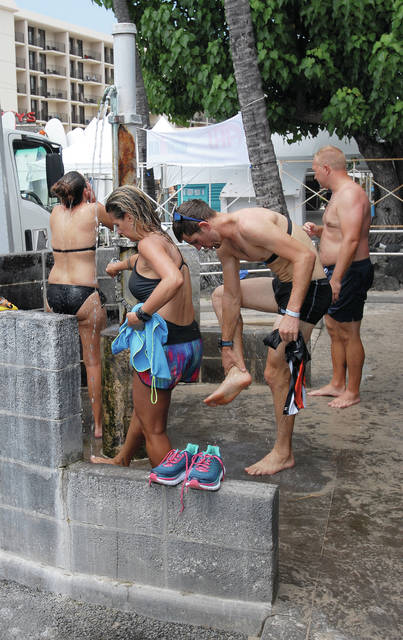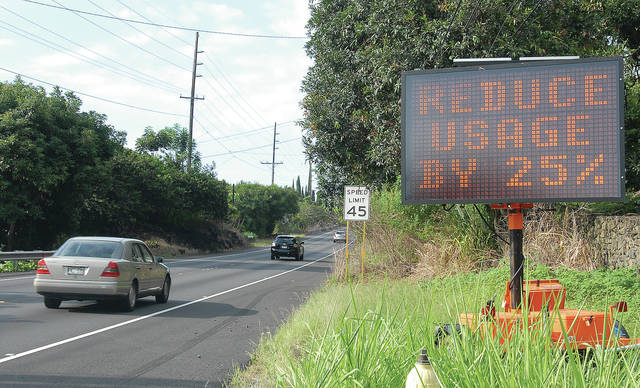KAILUA-KONA — During a two-day period leading up to today’s Ironman World Championship in Kona, about half of visitors responded with raised eyebrows or puzzled stares when asked if they knew Kona was short on water — and had been for several months — because of simultaneous equipment malfunctions at several area deep wells.
KAILUA-KONA — During a two-day period leading up to today’s Ironman World Championship in Kona, about half of visitors responded with raised eyebrows or puzzled stares when asked if they knew Kona was short on water — and had been for several months — because of simultaneous equipment malfunctions at several area deep wells.
“No,” said a surprised Steve Ehring, who arrived midweek from Pennsylvania to watch his son compete in the race. “I hadn’t heard anything about that.”
Ehring’s response highlights the struggles Big Island residents faced in trying to spread awareness of the water crisis — as well as the concerns they expressed in the weeks leading up to the event as the county Department of Water Supply scrambled to manage five downed wells in North Kona’s 13-well system.
Fortunately, it doesn’t appear as though Ironman will cause any water shortages in the North Kona area. Many visitors will depart within a few days and up to this point, DWS officials say the system has proven resilient.
“The tank levels have remained stable,” said DWS Deputy Kawika Uyehara.
He added it’s tough to gauge so quickly what the increase in water usage has been since Ironman visitors began to arrive, but that there’s no cause for concern.
There isn’t much evidence, however, that efforts to disseminate information had a lot to do with the ability of DWS to maintain water system integrity. The department kept up its 25 percent mandatory usage restriction signs along main roads, which were primary sources of enlightenment for some visitors in the know.
Ironman also sent out an email blast to all participants outlining the situation, but that, too, yielded mixed results.
Marisol Franco, a triathlete from Mexico, said she became aware of the water shortage because of the organization’s email. Martin Hauf, in from Germany for his first Ironman, never saw the electronic communication.
Vice President of Ironman World Championship Events Diana Bertsch said while DWS reached out to her to clue her in, there was never any mandate for her organization to inform the public of the water circumstances in Kona.
“We just did it on our own when the situation arose just because we have the avenue to communicate,” she said.
Large hotels in the area also weren’t mandated to directly inform guests upon arrival as to the water issues in West Hawaii.
“We can’t mandate that they say anything,” said county spokesperson Janet Snyder. “That’s up to them to do anything further. We can just tell them and ask them and try to persuade them.”
King Kamehameha’s Kona Beach Hotel and the Sheraton Keauhou are among the top five highest consumers of water in North Kona.
“We were not asked to do so,” said Niklas Dahm, assistant general manager at King Kamehameha’s Kona Beach Hotel. “So no, there was not (an effort to communicate with guests directly).”
Dahm added the hotel provides guests with a good deal of information when they check in, and the more information the hotel heaps on them “makes it very hard for the guests.”
Instead, he said, the hotel tried to make conservation efforts on its end, as the guests only use hotel water for hygiene and personal consumption in their rooms. The hotel’s efforts included halting irrigation and serving water at restaurants only upon request.
The Sheraton Keauhou did not respond to multiple requests for comment on its efforts to communicate information directly or indirectly to its guests about the water crisis or about the hotel’s attempts to conserve water on its own.
The “Fight the Bite” campaign in regard to the outbreak of dengue fever on the Big Island started in 2015 and stretched into 2016. It enlisted help from the state, the county, the tourism industry, Ironman and news media to curb the number of dengue cases.
The water crisis hasn’t spurred the same type of extensive informational campaign — or the level of urgency — despite legitimate fear throughout North Kona about what the surge of Ironman visitors might mean.
“I am absolutely worried,” Kona resident Kerry Key said earlier this week. “As long as the tap runs when they open it, (visitors) are going to use the water.”
DWS relieved some of the pressure by bringing two of the five inoperative wells back online earlier this month. Keith Okamoto, DWS manager and chief-engineer, said in September that water usage didn’t historically spike during Ironman.
His assertion was backed up by tourism statistics showing Ironman visitors tend to replace traditional tourists during this time of year and create an evening-out effect.
Still, several community members remain on edge. Their anxiety, however, turned out to be a grassroots informational tool in the absence of more traditional modes of communication.
In other words, people were scared, so they talked about it. And word spread. Multiple visitors staying in houses or condos said the island residents from whom they rented made them aware of the water shortage.
Sylvia Thiel, who returned to Kona this year to volunteer for her second consecutive Ironman, said she found lodging through Airbnb and those with whom she’s staying informed her.
And for her, at least, that knowledge made a difference.
“I don’t take a shower like three times a day because I’m sweating,” Thiel said. “I know I’m going to be sweating again 10 minutes later, so I reduce that. I am thinking about it and trying to take this into consideration in my daily routine.”
“It’s wonderful to be here, and I think it’s a beautiful island,” she added. “I hope that everybody thinks about those kind of things as well — how much we consume every day. Especially during an event like this.”
Email Max Dible at mdible@westhawaiitoday.com.


